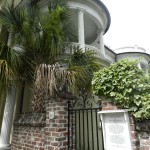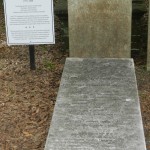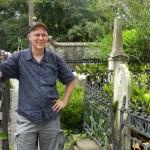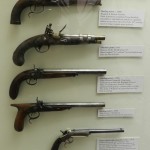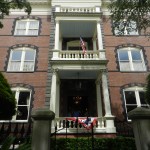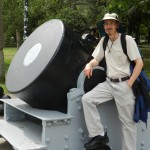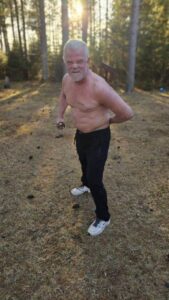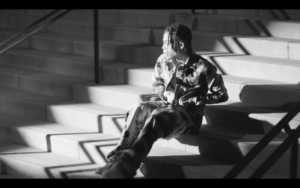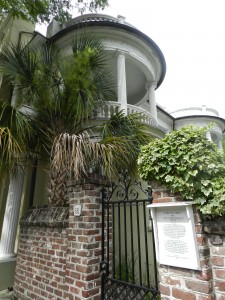
Successful travel often requires adjustments on the fly, so a brief online check of Charleston attractions brought us to The Charleston Museum, which was founded in 1773 and happens to be the oldest museum in the United States. It has prehistoric skeletons and ancient artifacts, but we were mostly interested in its collection of items from antebellum South Carolina. My favorites were the dueling pistols. After we finished there, we made our way to Battery Park on the southern tip of downtown to catch a glimpse of Fort Sumter in the harbor. We accomplished this as we admired the antique cannon and mortars mounted a few yards from the water, but even more rewarding was our discovery of the Historic District on our way to the park.
The first building we saw in the District was St. Michael’s Episcopal Church, completed in 1761 with a prominent steeple similar to St. Martin-in-the-Fields in London. We then noticed its adjoining graveyard, which we immediately visited, hoping to find interesting curiosities. We were not disappointed; among its eternal residents were two signers of the Constitution and Robert Hayne, a US Senator forever known for being on the receiving end of Daniel Webster’s famous oration. The overall appearance was what you would expect of a 250-year-old graveyard: big headstones jammed together among exotic flora and wrought iron—an ideal breeding ground for ghosts. The headstones of the prominent residents were in good shape, but others were so worn as to have lost all identifying markings. I wasn’t sure whether to view these as an object lesson of life’s transience or a cautionary tale to ensure that my headstone came from good marble.
We had seen references to Charleston’s grand houses prior to our trip, but we had made arrangements to visit two of America’s most famous homes, the Vanderbilts’ Biltmore and Thomas Jefferson’s Monticello, and any other historic residence seemed likely to be unimpressive by comparison. We had not anticipated, though, the visual impact of seeing blocks of such houses painted in bright colors and maintained like new. Many went so far as to have working gas lamps. With the additional exotic touch of the palmetto trees lining the streets, it was the most beautiful urban landscape I have had the pleasure to witness. It was easy to imagine that we had stumbled through a hole in the space-time continuum and found ourselves back a couple of centuries, with the providential removal of unsavory aspects of the time, such as chamber pots, slavery, and the occasional yellow fever epidemic. It seemed a wonderful place to take a special someone for a romantic walk, especially on a summer evening around sunset.
That would have to wait for another time, of course, but that was all right. One of the benefits of travel is finding places for return visits, and Charleston is now on my list. It may take a few years to get back there, but when I do, I’ll be sure to stay longer.
